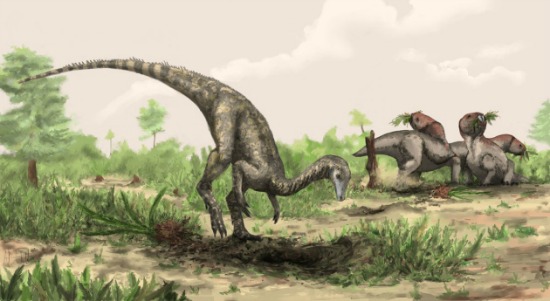Scientists Discover Oldest Known Dinosaur
A fragmentary skeleton pins the emergence of dinosaurs more than 10 million years earlier than previously thought
![]()
![]()

A restoration of Nyasasaurus in its Middle Triassic habitat, based on the known bones and comparisons to closely related forms. Art by Mark Witton.
For the past twenty years, Eoraptor has represented the beginning of the Age of Dinosaurs. This controversial little creature–found in the roughly 231-million-year-old rock of Argentina–has often been cited as the earliest known dinosaur. But Eoraptor has either just been stripped of that title, or soon will be. A newly-described fossil found decades ago in Tanzania extends the dawn of the dinosaurs more than 10 million years further back in time.
Named Nyasasaurus parringtoni, the roughly 243-million-year-old fossils represent either the oldest known dinosaur or the closest known relative to the earliest dinosaurs. The find was announced by University of Washington paleontologist Sterling Nesbitt and colleagues in Biology Letters, and I wrote a short news item about the discovery for Nature News. The paper presents a significant find that is also a tribute to the work of Alan Charig–who studied and named the animal, but never formally published a description–but it isn’t just that. The recognition of Nyasasaurus right near the base of the dinosaur family tree adds to a growing body of evidence that the ancestors of dinosaurs proliferated in the wake of a catastrophic mass extinction.
In March of 2010, Nesbitt and a team of collaborators named a leggy, long-necked creature from the same Triassic rock unit in Tanzania they named Asilisaurus kongwe. This creature was a dinosauriform–a member of the group from which the first true dinosaurs emerged–and, even better, appeared to to be the closest known relative to the Dinosauria as a whole. The find hinted that the dinosaur lineage had probably split off from a common ancestor by this time, meaning that the most archaic dinosaurs may have already existed by 243 million years ago. Roughly 249-million-year-old footprints of dinosauriforms found among Poland’s Holy Cross Mountains, described by different researchers later the same year, added evidence that the dinosauriforms were diversifying right from the beginning of the Triassic–not long after the catastrophe that decimated life on earth at the end of the Permian, around 252 million years ago.
Nyasasaurus is another step closer to the first true dinosaurs, and is just as old as Asilisaurus. To find an animal with such distinctive, dinosaur-like traits in the Middle Triassic indicates that dinosaurs already existed, or their ancestral stem was already established. Either way, Eoraptor and kin from South America can no longer be considered as the first dinosaurs, but rather a later radiation of forms. Even though our knowledge of Nyasasaurus is only fragmentary–the dinosaur is represented by a right humerus and a collection of vertebrae from two specimens–the dinosauriform nonetheless marks an additional 12 million years of dinosaur time that paleontologists are only just starting to explore.
Whether or not we ever achieve a more complete view of Nyasasaurus depends on the luck and the caprices of the fossil record. In the new paper, Nesbitt and coauthors point out that the rare, fragmentary nature of the remains found so far reflects that dinosauriforms–and early dinosaurs–were marginal parts of the ecosystems they inhabited. Dinosaurs did not dominate from the very start. They were relatively meek, small animals that lived in a world ruled by archosaurs more closely related to crocodiles. It was only in the Late Triassic and Early Jurassic, when their archosaurian competition was diminished, that dinosaurs became dominant. That means the earliest dinosaurs and their ancestors are few and far between in the Triassic record.
Still, when I asked Nesbitt what Nyasasaurus might have looked like, he cited other dinosauriforms and early dinosaurs as templates to constrain our expectations. Nyasasaurus may have looked quite like Asilisaurus–a leggy animal with an elongated neck–although Nyasasaurus may have been bipedal. Future finds will test this idea, but the fact remains that paleontologists are closing in on what the very first dinosaurs were like. As paleontologists uncover more early dinosaurs and dinosauriforms, the dividing line between the two disappears–scientists are starting to smooth out the evolutionary transition between the first dinosaurs and their ancestors. What role Nyasasaurus played in that transformation isn’t yet clear, but the creature is a signal that over 10 million years more of uncharted dinosaur history remains in the rock.
References:
Nesbitt, S., Sidor, C., Irmis, R., Angielczyk, K., Smith, R., Tsuji, L. 2010. Ecologically distinct dinosaurian sister group shows early diversification of Ornithodira. Nature 464, 7285: 95–98. doi:10.1038/nature08718
Nesbitt, N., Barrett, P., Werning, S., Sidor, C., Charig, A. 2012. The oldest dinosaur? A middle Triassic dinosauriform from Tanzania. Biology Letters. http://dx.doi.org/10.1098/rsbl.2012/0949
/https://tf-cmsv2-smithsonianmag-media.s3.amazonaws.com/accounts/headshot/RileyBlack.png)
/https://tf-cmsv2-smithsonianmag-media.s3.amazonaws.com/accounts/headshot/RileyBlack.png)